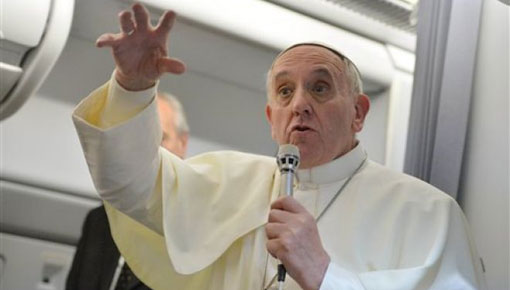
WASHINGTON – American CEOs and boards of directors should take note of Pope Francis’ recent suspension of the “Bishop of Bling,” whose excesses included a $20,000 bathtub and a $42 million renovation of the German bishop’s residence, writes United Steelworkers (USW) President Leo W. Gerard.
In a column on The Huffington Post, Gerard writes that Bishop Franz-Peter Tebartz-van Elst’s extravagances mirror the excessive pay and perks of far too many U.S. corporate princes and Wall Street barons such as “John Thain, the Merrill Lynch chief executive who bought a $35,000 toilet while spending $1.2 million on office renovations just months before confessing to $56 billion in losses.” Says Gerard:
Unlike Elst and Thain, Pope Francis is beloved for his asceticism. He lives in Spartan rooms and drives a 1984 Renault. He runs an organization as big as any American corporation. Yet he doesn’t demand millions in pay and perks. American CEOs, by contrast, place themselves on $35,000 thrones bought with the sweat of struggling minimum wage workers. The income inequality they’ve caused over the past half century is corrosive to the American ideal of an egalitarian society free of grotesquely wealthy royalty.
Click here to tell the SEC companies must disclose CEO-to-worker pay ratios.
The AFL-CIO Executive PayWatch calculates that CEOs of major corporations took home 354 times more pay than the average rank-and-file U.S. worker in 2012. Gerard outlines some of the most excessive of the excesses, such as former J.C. Penney Co. CEO Ron Johnson’s $53.3 million pay package. The average Penney’s employee earned $29,688.
That’s a ratio of 1,795 to one. It means the J.C. Penney board of directors decided that Johnson was worth 1,795 times the average Penney’s worker. Or, to put it another way, the J.C. Penney board determined that it would take 1,795 Penney’s workers to equal the talent of one Ron Johnson, a guy whose leadership resulted in a disastrous, money-losing 25 percent drop in sales.
Not too far behind is Oracle’s Lawrence Ellison, whose $96 million pay package in 2012 is 1,287 times what it pays the typical worker, says Gerard.
He also points that huge executive pay packages frequently don’t result in equivalent performance.
The Institute for Policy Studies reviewed the accomplishments of 241 corporate chief executives who ranked among America’s 25 top-paid CEOS in one or more of the past 20 years and found nearly 40% were bailed out by taxpayers, busted for fraud or booted like Johnson of Penney’s and Thain of the over-priced toilet fame.
While federal law has required corporations to reveal CEO pay, until the Dodd-Frank Wall Street reform bill was passed in 2010, they could keep secret the staggering difference between executive pay and the typical workers’ wages within their own companies.
It’s taken the U.S. Securities and Exchange Commission (SEC) three years to finally propose regulations requiring public companies to report the ratio between a CEO’s pay package and the pay of the median worker. As soon as the proposal became public, says Gerard:
CEOs and their lobbyists immediately redoubled their efforts to scuttle this requirement….CEOs and board members don’t want workers to get that pay ratio information. They don’t want workers to feel degraded, and thus a little less devoted. And they don’t want to be humiliated by shocking ratios at companies like J.C. Penney where the CEO’s decisions damaged the corporation.
While he urges the SEC to ignore corporate protests, he also suggests that corporate boards should behave more like Pope Francis, banishing imperial CEOs and rejecting royal pay package demands.
This article is reprinted from the AFL-CIO Now Blog.
Photo: Luca Zennaro/AP

MOST POPULAR TODAY

High Court essentially bans demonstrations, freedom of assembly in Deep South

Zionist organizations leading campaign to stop ceasefire resolutions in D.C. area

UN warns that Israel is still blocking humanitarian aid to Gaza

U.S. imperialism’s ‘ironclad’ support for Israel increases fascist danger at home







Comments